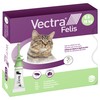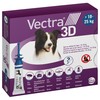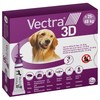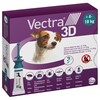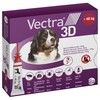Vectra
Vectra Spot On Solution is a monthly application for the treatment and control of fleas, ticks, sand flies, mosquitoes and stable flies. It offers fast acting and long lasting protection in a broad spectrum, and will provide a constant insecticidal and repellent effect over the month.
Vectra Spot On can also be used as part of a treatment strategy for flea allergy dermatitis (FAD).
Vectra Felis Spot On for Cats (3 Pack)
£16.00Vectra Felis Spot On is indicated for the treatment and prevention of parasites in cats older than 8 weeks and weighing over 0.6kg. The active substances in Vectra Felis act as...[More info]
Vectra 3D Spot On for Medium Dogs (3 Pack)
£19.00Vectra 3D Spot On is a powerful and broad-spectrum treatment for parasite control in medium breed dogs weighing 10 to 25kg. Vectra 3D works by creating a ‘hot foot’ reaction...[More info]
Vectra 3D Spot On for Large Dogs (3 Pack)
£19.99Vectra 3D Spot On is a powerful and broad-spectrum treatment for parasite control in large breed dogs weighing 25 to 40kg. Vectra 3D works by creating a ‘hot foot’ reaction that...[More info]
Vectra 3D Spot On for Small Dogs (3 Pack)
£16.99Vectra 3D Spot On is a powerful and broad-spectrum treatment for parasite control in small breed dogs weighing 4 to 10kg. Vectra 3D works by creating a ‘hot foot’ reaction that...[More info]
Vectra 3D Spot On for Extra Large Dogs (3 Pack)
£23.99Vectra 3D Spot On is a powerful and broad-spectrum treatment for parasite control in very large breed dogs weighing over 40kg. Vectra 3D works by creating a ‘hot foot’ reaction...[More info]
Vectra 3D Spot On for Extra Small Dogs (3 Pack)
£13.00Vectra 3D Spot On is a powerful and broad-spectrum treatment for parasite control in very small breed dogs weighing 1.5 to 4kg. Vectra 3D works by creating a ‘hot foot’ reaction...[More info]
Vectra 3D
Contra-indications, warnings, etc
Do not use in cases of hypersensitivity to any of the active substances or to any of the excipients.
Do not use on cats. Due to their unique physiology and inability to metabolise permethrin, this veterinary medicinal product must not be used on cats. If applied to a cat, or ingested by a cat that actively grooms a recently treated dog, this veterinary medicinal product may have serious harmful effects.
All dogs within the household should be treated. Cats in the household should only be treated with a veterinary medicinal product authorised for use in that species.
Fleas can infest the dog's basket, bedding and regular resting areas such as carpets and soft furnishings. In case of massive flea infestation and at the beginning of the control measures, these areas should be treated with a suitable insecticide and then vacuumed regularly.
Special precautions for use in animals
This veterinary medicinal product can induce convulsions in cats that could be fatal, due to the unique physiology of this species which is unable to metabolise certain compounds, including permethrin. In case of accidental exposure, if undesirable effects occur, wash the cat with shampoo or soap. To prevent cats from being accidentally exposed to the veterinary medicinal product, keep cats away from treated dogs until the application site is dry. It is important to ensure that cats do not groom the site of application on a dog which has been treated with this veterinary medicinal product.
The safety of the veterinary medicinal product has not been established in dogs younger than 7 weeks or weighing less than 1.5 kg.
Care should be taken to avoid contact between the veterinary medicinal product and the eyes of the dog. If in eyes, immediately flush with water.
The attachment of a single tick after treatment cannot be excluded. For this reason the transmission of infectious diseases cannot be completely excluded if conditions are favourable.
The veterinary medicinal product remains effective when treated animals are immersed in water (e.g. swimming, bathing). Water immersion repeated weekly for one month and starting 48 hours after treatment, as well as shampooing 2 weeks after treatment do not affect the efficacy of this product. However, in case of frequent shampooing, or bathing within 48 hours after treatment, the duration of activity may be reduced.
Do not mix with any other veterinary medicinal product, and do not apply together with any other veterinary medicinal product at the same time and site.
Special precautions to be taken by the person administering the veterinary medicinal product to animals
Do not eat, drink or smoke while handling the veterinary medicinal product. Wash hands thoroughly and immediately after use. This veterinary medicinal product is irritating to the eyes and skin. Avoid contact with the skin. In case of accidental spillage onto skin, wash off immediately with soap and water. If the veterinary medicinal product accidentally gets into the eyes, they should be thoroughly flushed with water. If skin or eye irritation persists, or if the veterinary medicinal product is accidentally swallowed, seek medical advice immediately and show the package leaflet or the label to the physician.
People with known hypersensitivity to any of the ingredients should avoid contact with the veterinary medicinal product.
Children must not handle treated dogs for at least four hours after administration of the veterinary medicinal product. It is therefore recommended to treat dogs in the evening, or before taking them for a walk. On the day of treatment, treated dogs should not be permitted to sleep with their owners, especially children. Used applicators should be disposed of immediately and not left within the sight or reach of children.
Wait for the application site to dry before allowing the treated dog to come in contact with fabrics or furnishings.
Adverse reactions
Transient erythema, pruritus or other signs of discomfort at the application site have been reported rarely and usually disappear spontaneously, within 24 hours following administration of the product. Behavioural disorders such as hyperactivity, vocalisation or anxiety, systemic signs such as lethargy or anorexia, and neurological signs such as muscle tremor have been reported in rare cases. Signs of ataxia such as unsteady movement have been reported in very rare cases. Gastrointestinal signs such as vomiting or diarrhoea have also been reported very rarely. Transient cosmetic effects (wet appearance, spiking of hair coat and deposits) at the application site have been reported very rarely, however these effects are usually not noticeable after 48 hours.
Use during pregnancy, lactation or lay
The safety of the veterinary medicinal product in bitches has not been established during pregnancy and lactation. The use of the veterinary medicinal product in pregnant and lactating bitches or in dogs intended for breeding should be based on a benefit/risk assessment by the responsible veterinarian. Laboratory studies, with each of the components, dinotefuran, pyriproxyfen or permethrin, in rats and rabbits have not produced any evidence of maternotoxic, teratogenic or foetotoxic effects. Dinotefuran has been shown to cross the blood-milk barrier and is excreted in the milk. N-methylpyrrolidone, an excipient in the veterinary medicinal product, has shown to be teratogenic in laboratory animals.
Overdose
Apart from erythema and cosmetic hair coat changes at the site of application, no adverse reactions were observed in healthy puppies aged 7 weeks, topically treated 7 times at 2 week intervals and with up to 5 times the highest recommended dose. After accidental ingestion of the highest recommended dose, vomiting, salivation and diarrhoea may occur, however these should resolve without treatment.
Interactions
None known.
Vectra Felis
Contraindications
Do not use in cats or kittens weighing less than 0.6 kg. Do not use in cases of hypersensitivity to the active substances or to any of the excipients.
Special warnings for each target species
All cats within the household should be treated. Dogs in the household should only be treated with a veterinary medicinal product authorised for use in that species. Fleas can infest the cat's basket, bedding and regular resting areas such as carpets and soft furnishings. In case of massive flea infestation and at the beginning of the control measures, these areas should be treated with a suitable insecticide and then vacuumed regularly. The impact of shampooing on the efficacy of the veterinary medicinal product has not been evaluated.
Special precautions for use in animals
The safety of the product has not been established in cats younger than 7 weeks or weighing less than 0.6 kg (see section "Contraindications"). Care should be taken to apply the dose to an area where the animal cannot lick it off (see section 4.9), and to ensure that animals do not groom each other immediately following treatment. Care should be taken to ensure that the contents of the spot-on applicator, or the applied dose, do not come into contact with the eyes of the cat to be treated and/or any other animals. No studies have been performed in sick or convalescent cats; therefore this veterinary medicinal product should only be used based on the benefit-risk assessment of the responsible veterinarian.
Special precautions to be taken by the person administering the veterinary medicinal product to animals
Wash hands thoroughly and immediately after use. The veterinary medicinal product is irritating to the eyes and skin. Avoid contact with the skin, eyes or mouth. In case of accidental spillage onto skin, wash off immediately with soap and water. If the veterinary medicinal product accidentally gets into the eyes, they should be rinsed with water immediately, with the eyelids open, and for a sufficient length of time. If skin or if eye irritation persists, or in case of accidental ingestion, seek medical advice immediately and show the package leaflet or the label to the physician. People with known hypersensitivity to dinotefuran, pyriproxyfen or dimethyl sulfoxide should avoid contact with this veterinary medicinal product. Treated animals must not be handled for at least eight hours after application of the product. It is therefore recommended to treat the animal in the evening. Treated animals should not be allowed to sleep with their owners, especially children, on the day of treatment. Used applicators should be disposed of immediately and not left within the sight or reach of children.
Adverse reactions (frequency and seriousness)
Slight scales, transient erythema and alopecia can be observed in rare cases, which usually disappear spontaneously without treatment. Transient cosmetic effects such as wet hair and a white dry residue may occur at the application site very rarely and may persist up to 7 days; however, these effects are usually not noticeable after 48 hours. These changes do not affect the safety or the efficacy of the veterinary medicinal product. Other application site disorders such as erythema, pruritus, lesions and inflammation may occur very rarely. Hyperactivity and tachypnoea may occur very rarely.
The frequency of adverse reactions is defined using the following convention:
- very common (more than 1 in 10 animals treated displaying adverse reaction(s))
- common (more than 1 but less than 10 animals in 100 animals treated)
- uncommon (more than 1 but less than 10 animals in 1,000 animals treated)
- rare (more than 1 but less than 10 animals in 10,000 animals treated)
- very rare (less than 1 animal in 10,000 animals treated, including isolated reports).
Use during pregnancy, lactation or lay
The safety of the veterinary medicinal product has not been established during pregnancy and lactation in adult female cats. Use only accordingly to the benefit/risk assessment by the responsible veterinarian. Laboratory studies with each of the components, dinotefuran or pyriproxyfen, in rats and rabbits have not produced any evidence of maternotoxic, teratogenic or foetotoxic effects. In rats, dinotefuran has been shown to cross the blood-milk barrier and is excreted in the milk.
Interaction with other medicinal products and other forms of interaction
None known.
Overdose (symptoms, emergency procedures, antidotes), if necessary
No clinically important adverse reactions were observed in healthy kittens aged 7 weeks or more, topically treated 7 times at 2 week intervals and with up to 4 times the highest recommended dose except transient oedema or dry skin at the application site. After accidental ingestion of the product, transient reactions such as salivation, abnormal faeces and emesis may occur, however these should resolve without treatment within 4 hours.
Withdrawal period(s)
Not applicable
